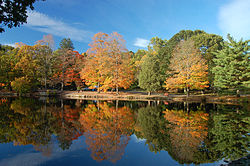Stamford Museum & Nature Center

Bendel Pond and Laurel Lake
|
|
| Founded | 1936 |
|---|---|
| Founder | Dr. G.R.R. Hertzberg |
| Type | 501(c)(3) non-for profit organization |
| Focus | Art, Agricultural Science, Natural Science, History |
| Location | |
| Coordinates | 41°07′34″N 73°32′49″W / 41.126°N 73.547°WCoordinates: 41°07′34″N 73°32′49″W / 41.126°N 73.547°W |
| Website | stamfordmuseum |
|
Formerly called
|
Stamford Museum |
The Stamford Museum & Nature Center, located in Stamford, Connecticut, is an art, history, nature, and agricultural sciences museum. The property covers 118 acres (ca. 48 hectares) beginning about half a mile north of the Merritt Parkway. It was originally a private estate.
Located in the woods of North Stamford, Connecticut, the 118-acre museum property is home to a 10-acre working farm, a Tudor-style museum and gallery which hosts exhibitions, an interactive nature center, 80 acres of outdoor trails, a large planetarium, a 4-story observatory with a research telescope, an otter pond, and a large playground designed for children to experience animals' perspective on nature.
In addition to the facilities, the SM&NC offers seasonal family-oriented exhibits and weekend festivals, year-round childhood educational programming, camps, and volunteer opportunities.
In 1936, the museum’s founders envisioned a safe and stimulating sanctuary where children and families could learn about the natural world, the agricultural sciences, astronomy, art, and history. Dr. G.R.R Hertzberg brought this philosophy to the first organizational meeting of the museum on January 20, 1936. The Stamford Museum was founded five months later, as a “cabinet of curiosities” model occupying three rooms at the Stamford Trust Company building at 300 Main Street. The original collection grew from community donations of birds, moths, butterflies, and other geological specimens. Opened to the public on June 27, 1936, this early incarnation of the museum drew families from the area, still its prime demographic today.
In 1938, the Hall of Mammals and the Hall of Geology & Mineralogy opened. In 1939, the museum was incorporated under a state charter which enabled it to receive public funds while still remaining autonomous. The Town and City of Stamford (there were two governments at that time) began contributing, and as the museum grew, so did the city and town’s contributions. The same year, the Hoyt Marine Hall opened.
By 1945, the museum was quickly outgrowing its small downtown location. The E.Y. Webster Estate deeded eight acres to the city of Stamford, creating the museum’s second location at Courtland Park. The former carriage house became the museum’s new home, and a small barnyard and wildlife area were constructed. Local artists were showcased in the small gallery, and a planetarium and weather station were constructed and installed. Opening to the public in 1946, the Courtland Park location was short-lived, as the Connecticut Turnpike claimed six of the eight acres in Courtland Park in 1955. Once again, the burgeoning museum sought another, larger location.
...
Wikipedia
